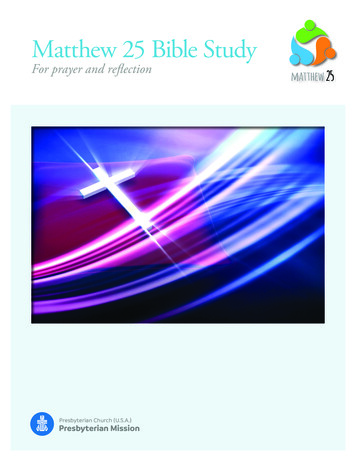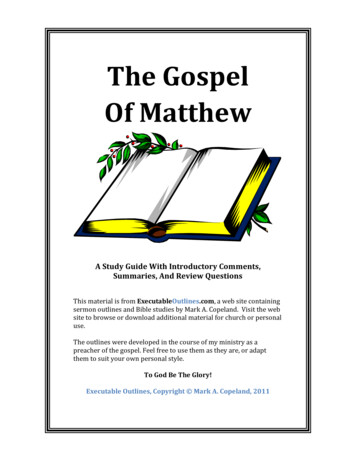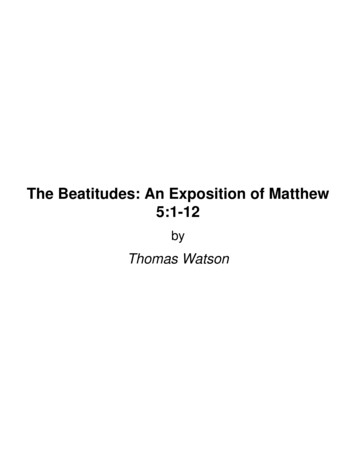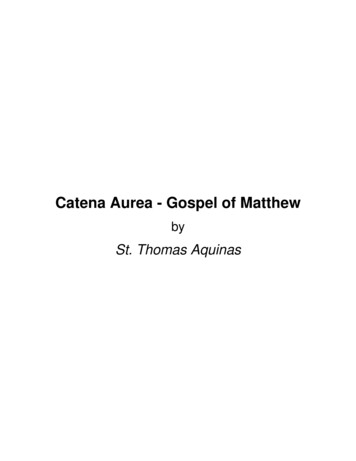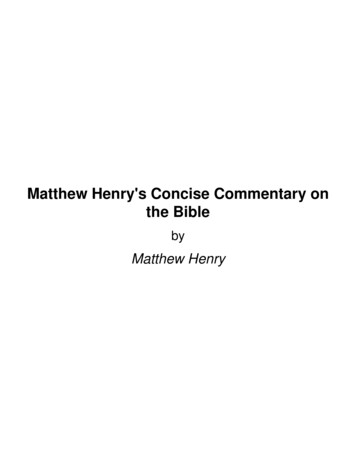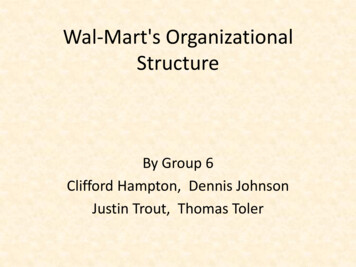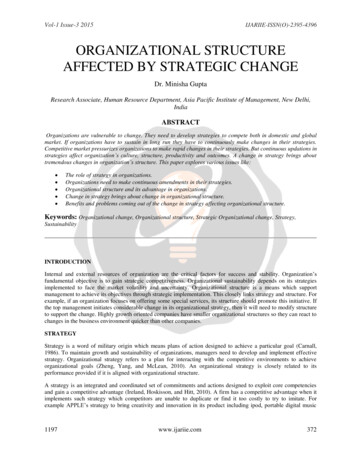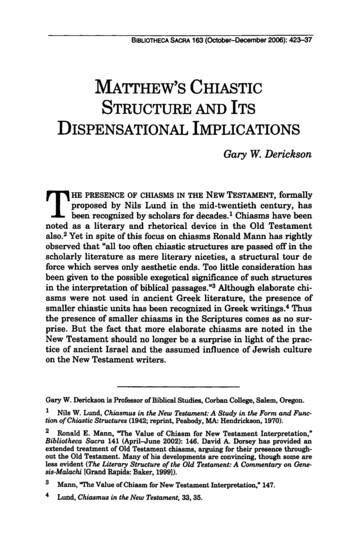
Transcription
BiBLlOTHECA SACRA 163 (October-December 2006): 423-37MATTHEW'S CHIASTICSTRUCTURE AND ITSDLSPENSATIONAL IMPLICATIONSGary W. DericksonTHE PRESENCE OF CHIASMS IN THE NEW TESTAMENT,formallyproposed by Nils Lund in the mid-twentieth century, hasbeen recognized by scholars for decades.1 Chiasms have beennoted as a literary and rhetorical device in the Old Testamentalso.2 Yet in spite of this focus on chiasms Ronald Mann has rightlyobserved that "all too often chiastic structures are passed off in thescholarly literature as mere literary niceties, a structural tour deforce which serves only aesthetic ends. Too little consideration hasbeen given to the possible exegetical significance of such structuresin the interpretation of biblical passages."3 Although elaborate chiasms were not used in ancient Greek literature, the presence ofsmaller chiastic units has been recognized in Greek writings.4 Thusthe presence of smaller chiasms in the Scriptures comes as no surprise. But the fact that more elaborate chiasms are noted in theNew Testament should no longer be a surprise in light of the practice of ancient Israel and the assumed influence of Jewish cultureon the New Testament writers.Gary W. Derickson is Professor of Biblical Studies, Corban College, Salem, Oregon.Nils W. Lund, Chiasmus in the New Testament: A Study in the Form and Function of Chiastic Structures (1942; reprint, Peabody, MA: Hendrickson, 1970).2Ronald E. Mann, "The Value of Chiasm for New Testament Interpretation,"Bibliotheca Sacra 141 (April-June 2002): 146. David A. Dorsey has provided anextended treatment of Old Testament chiasms, arguing for their presence throughout the Old Testament. Many of his developments are convincing, though some areless evident (The Literary Structure of the Old Testament: A Commentary on Genesis-Malachi [Grand Rapids: Baker, 1999]).3Mann, "The Value of Chiasm for New Testament Interpretation," 147.4Lund, Chiasmus in the New Testament, 33, 35.
424BiBLiOTHECA SACRA / October-December 2006THE STRUCTURE AND NATURE OF CHIASMSBoth Old and New Testament authors used various structural devices for literary purposes.5 Traina identifies five kinds of structural units a biblical author may have used in "constructing" hismessage: biography (persons), history (events), chronological material (time elements), geography (places), or logical arrangements(ideas).6 Chiasms may employ any of these materials within theirstructure, but invariably chiasms reflect a logical arrangement ofideas that serve to focus the reader on the point being made by theauthor, whether explicitly stated or implied.As a literary device a chiasm may be a small unit of as few asthree lines or it may encompass a complete literary work such asthe Pentateuch. Though one key trait of chiasms is the repetition ofmaterial in reverse order, its arrangement of material does morethan that.7 Its structure serves to point the reader or ancient listener to its central section as the significant element.8 The otherparallel pairs of units contribute to that message, but the centralunit or units serve as its teaching point. Mann explains the significance of the parts of a chiasm. He notes that "two characteristics ofchiasm help interpreters understand the meaning of biblical passages: (1) the presence of either a single central or of two complementary central elements in the structure, which generally highlight the major thrust of the passage encompassed by the chiasm;and (2) the presence of complementary pairs of elements, in which5Dorsey, The Literary Structure of the Old Testament, 36.6Robert A. Traina, Methodical Bible Study (Grand Rapids: Francis Asbury,1952), 55-56.7Scot Mcknight, "Literary Criticism of the Synoptic Gospels," Trinity Journal 8(spring 1987): 68.8Dorsey, The Literary Structure of the Old Testament, 44. Lund lists seven "laws"of chiastic structures: a (l) The centre is always the turning point. (2) At the centre there is often a change in the trend of thought, and an antithetic idea is introduced. After this the original trend is resumed and continued until the system isconcluded. [This is] the law of the shift at the centre. (3) Identical ideas are oftendistributed in such a fashion that they occur in the extremes and at the centre oftheir respective system, and nowhere else in the system. (4) There are also manyinstances of ideas, occurring at the centre of one system and recurring in the extremes of a corresponding system, the second system evidently having been constructed to match the first. . . . [This is] the law of the shift from centre to the extremes. (5) There is a definite tendency of certain terms to gravitate toward certainpositions within a given system. . . . (6) Larger units are frequently introduced andconcluded by frame-passages. (7) There is frequently a mixture of chiastic and alternating lines within one and the same unit" (Chiasmus in the New Testament, 40-41[italics his]).
Matthew's Chiastic Structure and Its Dispensational Implications 425each member of a pair can elucidate the other member and together form a composite meaning."9 He also observes that theauthor may relate the complementary pairs in either synonymousor antithetical parallelism. Their placement strengthens the comparison or the contrast.10 Mann adds, "The [central] point may beobvious even without recognizing the chiasm; but the chiasmserves to highlight and heighten the effect of this emphasis in theminds of the readers, even on an unconscious level."11 More importantly, though, the author's choice of a chiastic structure is designed to help communicate his idea "through the emphases andmovements inherent in the structure."12 Thus the material doesnot lose its significance as it moves further from the center, butrather is shown to be related to that center in some significantway.THE CHIASTIC STRUCTURE OF MATTHEWThe presence of chiasms in Matthew's Gospel is commonly accepted.13 But few have noted the possibility that the entire Gospelmay be an extended chiasm, much like that of the Pentateuch.14The Gospel of Matthew reflects a complex chiasm that stretchesfrom its first chapter to the last, involving the narrative sections aswell as the five discourses. Not every element in each section hasan equivalent element in the parallel section. But Matthew incorporated enough literary clues and parallel elements to alert his9Mann, "The Value of Chiasm for New Testament Interpretation," 147-48.10Ibid., 148.11Ibid., 150.12Ibid., 153.For example Lund notes such chiasms (Chiasmus in the New Testament,233-35, 241-301). However, his chiasms seem more fanciful than clear.14Several commentators outline Matthew's Gospel around Jesus' five discourses inthe book (e.g., B. W. Bacon, "The Tive Books' of Matthew against the Jews," Expositor 15 [1918]: 56-66; and Stanley D. Toussaint, Behold the King: A Study of Matthew [Portland, OR: Multnomah, 1980], 24). Others divide the book at 4:17 and16:21 based on the phrase, "From that time Jesus began to . . ." (e.g., J. D.Kingsbury, Matthew: Structure, Christology, Kingdom [Philadelphia: Fortress,1975]; C. H. Lohr, "Oral Techniques in the Gospel of Matthew," Catholic BiblicalQuarterly 23 [1961]: 403-35), P. F. Ellis, Matthew: His Mind and His Message [Collegeville, MN: Liturgical, 1974], and H. J. B. Combrink ("The Structure of the Gospel of Matthew as Narrative," Tyndale Bulletin 34 [1983]: 61-90). Craig L. Blomberg rejects the chiastic structure, suggesting instead a blend of the three-part division of the Gospel and the role of the five discourses (Matthew, New AmericanCommentary [Nashville: Broadman, 1992], 22).
426 BiBLiOTHECA SACRA / October-December 2006audience to the relationships of those units as well as the development of his message.Matthew recorded many events in Jesus' ministry logicallyrather than chronologically, though he did use chronological markers in some sections. Toussaint notes this logical arrangement andsays the Gospel is built around five discourses that are marked offby the same concluding descriptive formula, "when Jesus had finished" (Matt. 7:28; 11:1; 13:53; 19:1; 26:1). He sees the addresses asconnected and climactic to the narrative sections that precedethem. Matthew, he says, used the narrative sections as preparatoryand introductory to the five discourses. 15 However, recognizingMatthew's chiastic structure helps account for the final chaptersand relates them to the Gospel's four introductory chapters.A.Demonstration of Jesus' Qualifications as King (chaps. 1-4)Sermon on the Mount: Who Can Enter His Kingdom (chaps.5-7)C. Miracles and Instruction (chaps. 8-9)D. Instruction to the Twelve: Authority and Message for Israel (chap. 10)E. Opposition: The Nation's Rejection of the King (chaps.11-12)F. Parables of the Kingdom: The Kingdom Postponed(chap. 13)E.' Opposition: The Nation's Rejection of the King (chaps.14-17)D.' Instruction to the Twelve: Authority and Message for theChurch (chap. 18)C ' Miracles and Instruction (chaps. 19-23)B / Olivet Discourse: When the Kingdom Will Come (chaps. 24-25)A.' Demonstration of Jesus' Qualifications as King (chaps. 26-28)B.Matthew's eleven-part chiastic structure includes five parallelpairs of material. As noted earlier, not every element in each unitToussaint, Behold the King, 24. For example he says chapters 8-9 show Jesus'authority as Messiah, which authority He then granted to His disciples in chapter10. Toussaint's point is good. But it does not account for the final section of Matthew, chapters 26-28, which would then have to be seen as an epilogue to the Gospel. However, when Matthew is viewed as a chiasm, the parallel between the firstand final sections becomes significant. Both sections prove Jesus' qualification to bethe Messiah. In the first section (chaps. 1-4) His legal qualification is demonstratedthrough His genealogy, His moral qualification is demonstrated through the temptations, and His spiritual qualification through His baptism. In the final section(chaps. 26-28) He is both proven to be and recognized as the Messiah by His resurrection appearances and His declaration of authority as He gave His followers instructions on what they are to do before He returns to set up His promised kingdom.
Matthew's Chiastic Structure and Its Dispensational Implications 427has a corresponding element in its parallel unit. But sufficientpoints of contact occur that enable readers to recognize the pointbeing made by that pair.Chapters 1-4 are parallel to chapters 26-28, for in both sections a non-Jewish ruler attempted to kill Jesus, and in both instances this occurred after the ruler was told that Jesus is King ofthe Jews. Herod failed while Pilate succeeded. In both sections theJewish leaders assisted their ruler and did not believe in Jesus. Inthe first section Jesus escaped death by going to Egypt, but in thesecond section He conquered death by rising from the grave.Chapters 5-7 are parallel to chapters 24-25, for in both sections Jesus addressed the nation of Israel as its King. In chapters5-7 Jesus, the messianic King, described the character traits ofcitizens of His kingdom, and in doing so He declared who will beallowed to enter His kingdom.16 At this time the kingdom was stillexpected and was offered to Israel. In chapters 24-25 the kingdomwas delayed because of the nation's rejection of the offer in chapters 11-12.17 In chapters 24-25 Jesus again addressed the nationof Israel in response to questions from His disciples. He spoke ofthe signs Israelites should watch for in order to be prepared for Hisreturn to set up the postponed kingdom. Thus Jesus' answer to Hisdisciples may be seen as addressing Israel in the same sense as theSermon on the Mount.Chapters 8-9 are parallel to chapters 19-23. Both recount Jesus' instructions about discipleship and the coming kingdom aswell as giving reports of Jesus' miracles. Chapters 8-9 record miracles that are divided by two pericopes on discipleship.18 Then inchapters 19-23, the section following the second set of instructions,Matthew recounted Jesus' instructions to His disciples and notedother miracles He performed. Where the first section emphasizesJesus' miracles and touches on discipleship, the second section emphasizes Jesus' instructions to those who were His disciples andMatthew's portrayal of Jesus as Israel's rightful King is clear in the first fourchapters. Thus the Sermon on the Mount can legitimately be viewed as the addressof the nation's rightful King to Israel. Also significant is the fact that Jesus saidentrance into the kingdom depended on works, not faith, and so He was speaking ofsanctification, not justification.17This is seen in the opposition Jesus experienced in these chapters as well as theclimactic rejection of His family at the very end of the section and before the introduction of the parables of the kingdom in chapter 13.In the first (8:18-22) two potential disciples are told the cost of discipleship. Inthe second (9:9-13) Matthew was called to be Jesus' disciple and left everything tofollow Him.
428 BiBLiOTHECA SACRA / October-December 2006only mentioned His miracles. They cover similar themes but withdiffering focuses.Chapters 10 and 18 are parallel in that both include Jesus'instructions to the twelve apostles. In chapter 10 the kingdom wasstill being offered to the nation. And so the disciples were sent toIsrael to announce the nearness of that kingdom. In chapter 18 thekingdom was no longer being offered, for it had been rejected bythe nation. Instead of a message for Israel, Jesus gave His disciplesinstructions on the life of the church. Though the instructions tothe disciples in these two sections differ, in both instances theTwelve were being instructed. This is similar to the pattern in thePentateuch in which Exodus and Numbers both recount the na tion's experiences in the wilderness. Their specific contents are dif ferent, but their "wilderness" connection and roles in the structureof the Pentateuch are unmistakable.Matthew 11-12 is parallel to chapters 14-17. These sectionsseem to have the most points of contact. John the Baptist was im prisoned (chap. 11) and executed (chap. 14). The conflicts Jesusfaced with the Jews in the grain field and synagogue (12:1-14) areparallel to the Jews' objections to Jesus' disciples transgressingJewish traditions (15:1-20). In both sections Jesus healed manypeople (12:15-32 and 15:29-31), and in both sections the Phari sees/rulers asked for a sign, and each time Jesus mentioned onlythe sign of Jonah (12:38-42 and 16:1-4). Most significantly thefirst section ends with Jesus rejecting His family, representative ofthe nation (12:46-49), and the second section begins with Jesus'hometown rejecting Him (13:53-58).At the center of the parallel sections are the parables of thekingdom (chap. 13), which may themselves be arranged as a chi asm.1919Mark L. Bailey, "Guidelines for Interpreting Jesus' Parables," Bibliotheca Sacra155 (April-June 1998): 173. He describes them as follows: "Each of the two sectionsin Matthew 13 (w. 1-35 and w . 36-52) includes a statement of setting (w. l-3a;36a), an excursus (w. 10-23; 36b-43), four parables (w. 4-9; 24-33; 44-50), and aconclusion (w. 34-36; 51-52). While many scholars say Matthew 13 has seven par ables, the possibility of an eighth may be suggested by two observations. First, inverse 52 the phrase όμοιος ¿GTLU is the masculine equivalent of the feminine formused earlier to introduce other parables (όμοια ècrriv, w . 31, 33, 44, 45, 47). Second,the concluding clause immediately following verse 52 is the Matthean formula thatserves as a textual marker to indicate the ends of the five major narrative/discoursecycles (7:28; 11:1; 13:53; 19:1; 26:1)." Blomberg identifies the chiastic structure ofthe parables and uses it to argue for his view that Matthew's Gospel reflects a polarization theme (Matthew, 212).
Matthew's Chiastic Structure and its Dispensations Implications 429THE SIGNIFICANCE OF MATTHEW'S CHIASTIC CENTERMatthew's placement of the parables at the center of his Gospel ispurposeful and thus exegetically significant. Toussaint's discussionof Matthew's purpose is both insightful and helpful in understanding the message of the Gospel. He begins by detailing his understanding of how Matthew, Mark, Luke, and John developedtheir messages.These books were not written merely to convey theological concepts orto relate a story. These are important, but the primary purpose of thegospel writers was to prove a point. In other words, they wrote theirGospels with the intention of setting forth an argument. In order toattain this objective the evangelists were very selective in their choiceof materials. Those elements were placed in the fore which would assist them in accomplishing their purpose. Therefore one writer may attimes emphasize doctrine; at other times he may underscore a seriesof events. Both doctrine and narration may20be used, but their use isall for the sake of setting forth an argument.Once one sees the parables of the kingdom as the center ofMatthew's message, he must then ask what point was being madeby the parables. Again Toussaint addressed this issue. "The answercan only be found by observing the main emphases of Matthew'sGospel and noting the logical development of those emphases. . . .Neither the significance of the life of Christ narrated by Matthewnor the doctrines contained in his Gospel are intelligible withoutan understanding of his argument."21 Then, observing the data ofthe text, he argues that the Gospel was written to Jewish believersbased on "the author's style, by the vocabulary of the Gospel, by itssubject matter, by the use it makes of Old Testament quotations,by the genealogy of chapter one, by its emphasis on Peter, by theunexplained customs related in the book, and by the testimony oftradition."22 From this he concludes, "Matthew has a twofold purpose in writing his Gospel. Primarily he penned this Gospel toprove Jesus is the Messiah, but he also wrote it to explain God'skingdom program to his readers."23 Matthew presented God's20Toussaint, Behold the King, 13-14.21Ibid., 15.22Ibid., 18.23Ibid. Toussaint adds, "A nonbelieving Jew would scoff at any assertion of theLord Jesus being the Messiah, let alone King. If Jesus is the Messiah of Israel,where is His kingdom? Where is the fulfillment of the Old Testament promises toIsrael?' he would ask. After all, the Hebrew Scriptures are replete with foreviews ofa Utopian age headed by Israel and their Messiah. Therefore, the objector would
430 BiBLiOTHECA SACRA / October-December 2006kingdom program "in three aspects. First, the earthly literal kingdom was offered to Israel in the person of Jesus, the Messiah, atHis first coming. Second, the kingdom was postponed because Israel rejected its Messiah. This postponed kingdom will be established at Christ's second coming. Third, Christ Jesus is now engaged in building His church, composed of those who in this ageare the heirs of the kingdom."24THE MEANING OF THE KINGDOM OF HEAVENIn the parables of the kingdom Jesus referred repeatedly to thekingdom of heaven.25 But to which kingdom was He referring?Couch correctly notes that "though Bible teachers of many persuasions recognize a universal kingdom of God's reign and rule, theexpressions kingdom of God and kingdom of heaven for the mostpart refer to the coming millennial reign of Christ on earth. . . .John, Mark, and Luke used the expression kingdom of God exclusively. They do not refer to the kingdom of heaven at all. But inreverse, Matthew uses the phrase kingdom of heaven some thirtycontend Jesus could not be the Messiah because He did not fulfill Old Testamentprophecies promising a kingdom for Israel."Because of the validity of this objection, Matthew explains God's kingdom program as it relates to Jesus, to Israel, and to the church. He shows first of all that theJews rejected an earthly kingdom when they rejected their King (21:28-22:10;11:16-24). He then goes on to show that because Israel rejected its King, its Kingdom is postponed. . . . In the meantime God has inaugurated an entirely new andpreviously unknown program. It involves the church of the present age which Christpredicted in Matthew 16:18. Because of the universal character of the church, Matthew also has an emphasis on Gentiles. Only Matthew mentions the word church.He refers to the Magi from the East, the Gentile centurion's great faith, the Canaanitish woman, the promise of the universal proclamation of the kingdom (24:14),and the final great commission. Matthew has a definite universal emphasis to provethat the kingdom program of God also embraces Gentiles" (ibid., 19, [italics his]).2425Ibid., 20.Toussaint correctly notes that the term, "kingdom of heaven" occurs only inMatthew's Gospel and "is distinctly Jewish" in nature (ibid., 16). Bailey observes,"The definition of the kingdom has been one of the most widely debated issues inSynoptic scholarship. However, the study of the kingdom in relationship to the parables has often been neglected. Studying the parables in this light helps interpretthe kingdom within the progressive revelation of the life and teaching of JesusChrist as He presented Himself and the message of the kingdom to Israel. Regardless of one's interpretation of the kingdom, it is difficult to dispute that the kingdomis the primary referent of the majority of the parables. Too often the interpreter'sbias about the kingdom has been forced into parabolic exegesis rather than allowingthe parables to inform the theology of the kingdom. More work is needed to allowthe parables to unfold the biblical doctrine of the kingdom as the message of Jesuscontributed to it" ("Guidelines for Interpreting Jesus' Parables," 37).
Matthew's Chiastic Structure and Its Dispensational Implications 431times and kingdom of God only three times!"26 Beacham identifiesthe kingdom as "two overlapping yet distinguishable realms." Thefirst is God's universal kingdom, His rule "at all times over everyaspect and entity of the created order," and the second is His "rulethat is localized on earth, framed within time, and centered on aselect human constituency."27 Beacham says this mediatorial kingdom was expressed as the kingdoms of Israel and Judah and willbe expressed as the future messianic/millennial kingdom. He differs from Chafer, Pentecost, Ryrie, and Walvoord, who say that"kingdom" in Scripture carried "multiple senses" beyond the two,the universal and mediatorial kingdoms of God.28THE MEANING OF THE PARABLES OF THE KINGDOMJesus' parables should be interpreted within the context of theirhistorical framework, looking to the immediate context for help inunderstanding both the reason for them as well as their meaning.29Since Matthew's material is arranged logically rather thanchronologically, one needs to note how he used the parables as wellas the details of their immediate contexts.3026Mai Couch, "Kingdom of God, of heaven," in Dictionary of Premillennial Theology, ed. Mal Couch (Grand Rapids: Kregel, 1996), 230 (italics his).27Roy E. Beacham, "Kingdom, Parables of the," in Dictionary of PremillennialTheology, 235.8Ibid. For example J. Dwight Pentecost identifies seven different senses of theword "kingdom": "(1) the Gentile kingdoms, (2) the kingdoms in Israel and Judah,(3) the kingdom of Satan, (4) God's universal kingdom, (5) a spiritual kingdom, (6)the millennial Davidic kingdom, and (7) the mystery form of the kingdom" (Thingsto Come: A Study in Biblical Eschatology [Grand Rapids: Zondervan, 1958], 142).However, Pentecost also discusses the two distinct aspects of the kingdom. "Wemust recognize that the kingdom over which God rules is not self-contradictory;instead, it has two separate aspects that can be described a number of ways. Onemight say there is an eternal aspect as well as a temporal aspect; it has a universalnature as well as a local nature; or there is an immediate sense of the kingdom inwhich God rules directly, and a mediated sense of the kingdom in which God rulesindirectly through appointed representatives" (Thy Kingdom Come [Wheaton, IL:Victor, 1990], 15 [italics his]).Bailey notes that "parables can be interpreted properly only by understandingthe audience and the occasion that promoted them" ("Guidelines for InterpretingJesus' Parables," 32). He says further, "To discover the need that prompted the parable is a significant step toward unlocking its meaning within its original context"(ibid., 34).30Walter C. Kaiser and Moisés Silva, An Introduction to Biblical Hermeneutics(Grand Rapids: Zondervan, 1994), 113-14. Even though Matthew is logically arranged, and though these parables are located differently in other Gospels, probablyJesus spoke these parables together on a single occasion. In fact Matthew's re-
432 BiBLiOTHECA SACRA / October-December 2006Jesus communicated the parables of the kingdom in Matthew13 to His disciples in order to teach them the mysteries of God'skingdom program. And since the disciples were looking for a literal, physical, political, Jerusalem-based kingdom as described bythe Old Testament prophets, Jesus' instruction must be seen inlight of that expectation. Also the fact that Jesus "rejected" Hisfamily (12:48-50) just before He taught the parables and was rejected at Nazareth right after He taught the parables (13:53-57)shows that Jesus gave the parables with His and the nation's rejection in mind. As Beacham writes, "These parables were not spokenby Christ at the inception of His ministry in order to redefine theprophesied kingdom or to correct Jewish misconceptions aboutMessiah's rule. Rather, the kingdom parables were spoken byChrist later in His ministry, at a point of crisis in the offer of therestored kingdom to Israel. . . . The kingdom parables, then, werenot intended to define the kingdom in its offer but to explain theeffects of its rejection. The contextual setting that envelopes thekingdom parables (Matt. 10:1-16:21) must not be ignored in theirinterpretation."31 Thus, as Bailey writes, "The parables in Matthew13 focus on the phase of God's kingdom program that extends fromthe time of Israel's rejection of Jesus in His earthly ministry to thetime of judgment at His second coming."32Interpretation of the parables must take into account the eternal, unconditional covenants between God and Israel's patriarchsand kings. Pentecost correctly observes that "the Davidic kingdomprogram would not be cancelled. It could, however, be postponed."33He notes that in the parable of the ten minas (Luke 19:11-27) Jesus taught that "the kingdom offer was being withdrawn from thatgeneration and the Davidic form of the theocracy postponed."34Since the kingdom was being delayed by Jesus, the parablesneed not refer to the millennial kingdom as some dispensationalists take them.35 Rather, they describe the interadvent period ofcounting of details such as their movement to the house and His change from anaudience of many to the Twelve indicates that Jesus did in fact teach these parablesin a single setting soon after rejecting His family and the nation.31Beacham, "Kingdom, Parables of the," 232.32Mark L. Bailey, "The Doctrine of the Kingdom in Matthew 13,* Bibliotheca Sacra 156 (October-December 1999): 446.33Pentecost, Thy Kingdom Come, 233.34Ibid.35For example Mike Stallard says that "any interpretation of Matthew's kingdomparables must understand at the outset the concrete essence of the kingdom as
Matthew's Chiastic Structure and Its Dispensation Implications 433God's rule that will continue until Israel is ready to welcome herKing as promised in Scripture.36The parables also need not describe the church as such, thoughthe church age is included within the scope of their time frame."The aorist passive form of the verb (ώμοιώθη) indicates that Jesusviewed the kingdom of heaven as having present reality. This par able describes a stage in God's kingdom program that has alreadybegun—the present form of God's rule, which is explained as 'themysteries of the kingdom of heaven' (v. II)."37 The "parables do notprimarily concern the nature, function, and influence of the church.Rather, they show the previously unrevealed form in which God'stheocratic rule would be exerted in a previously unrevealed age,made necessary by Israel's rejection of Christ."38 It is through thisnew program that God expresses His sovereign rule in the presentperiod of human history.39JESUS' STATEMENTS THAT INDICATE A DELAYED KINGDOMMatthew included statements by Jesus that hint at the kingdom'sdelay and other statements that clearly point to the delay.The first hint of the kingdom's delay is in His response to thequestion by John the Baptist's disciples about fasting (Matt.9:14-15). Jesus alluded to His coming absence by referring to agroom being absent from his wedding feast, symbolic of Messiah'skingdom. His disciples will fast, but only after He, the groom, isgone. In weddings in those days the groom would be gone until justtaught by the Old Testament. The Jews did not usually think in abstract termsabout such things. Therefore, the literal, earthly, political, and ethnic nature of thekingdom as understood in such passages as Amos 9, Daniel 7, Isaiah 11, and Ezekiel36-48 form a backdrop to one's reading of Matthew, the most Jewish of Gospels"("Hermeneutics and Matthew 13: Part II," Conservative Theological Journal 5 P e cember 2001]: 324-25). Stallard's view is just one of several approaches to the issue.Beacham describes the diversity of views within dispensationalism. "A variety ofcontrasting views attend these parables even among premillennialists and dispensationalists. Some believe, for example, that the kingdom parables relate to Jewishinterests only or describe the future millennial age exclusively. Others believe thatthese stories redefine the kingdom and correct mistaken Jewish views about God'srule. Some contend that the parables d
Sep 09, 2019 · pel of Matthew as Narrative," Tyndale Bulletin 34 [1983]: 61-90). Craig L. Blom-berg rejects the chiastic structure, suggesting instead a blend of the three-part divi sion of the Gospel and the role of the five discourses (Matthew, New American

